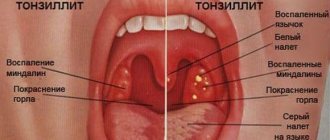Treatment methods for bacterial tonsillitis
Modern medicine uses two methods of treating bacterial tonsillitis - surgical and conservative.
Regardless of the stage and type of disease, you should not self-medicate. Since the drugs that helped cope with the disease once, the next time they may not cope with the infection. Therefore, you should definitely consult a doctor. The doctor at the ENT clinic will conduct an examination, prescribe the necessary tests (culture of flora from the throat) and prescribe a prescription for effective medications.
Bacterial tonsillitis in adults can only be cured with complex therapy, which combines various drugs for symptomatic therapy. In addition to drugs aimed at combating pathogens, medications are also prescribed that help reduce the intensity of accompanying symptoms, for example, to reduce body temperature and eliminate headaches.
In order to reduce a fairly high temperature (above 38.50C), you need to take one of the following medications:
- Ibuprofen;
- Paracetamol and others;
In a child, hyperthermia is often accompanied by nausea and vomiting. Traditional methods will help cope with hyperthermia - wiping the face and body with a damp towel or alcohol solution. During treatment of bacterial tonsillitis, bed rest and a gentle diet are mandatory. In case of intoxication, it is recommended to drink a lot of fluids (herbal infusions, compotes, milk, teas).
Based on the results of an analysis of the throat flora, the pathogen is determined and an antibiotic is prescribed, the action of which is aimed at combating this particular bacterium. For severe headaches accompanying bacterial tonsillitis, painkillers are prescribed - Aspirin, Ketonal, Nimesulide, Analgin.
Painful sensations in the throat are dulled and the tonsils are simultaneously disinfected when using the following medications:
- Givalex;
- Yox;
- Theraflu;
- Hexoral;
- Inhalipt.
Lollipops that reduce inflammation - Grammidin, Neo-angin, Decathylene, Strepsils - also cope well with this task. Solutions for gargling the mucous membranes of the throat - Chlorhexidine, Furacillin solution.
The surgical treatment for bacterial tonsillitis involves surgical removal of the tonsils. It should be borne in mind that these organs are of great importance for immunity.
Prevention of tonsillitis
In order to prevent tonsillitis in a child, parents should adhere to the following rules:
- Gradually harden the child's body.
- Provide your child with a balanced, healthy diet containing all the nutrients necessary for childhood.
- From a very early age, introduce the child to sanitary standards - the rules of washing hands, brushing teeth, etc.
- Promptly eliminate any inflammatory processes in the oral cavity and pharynx.
- Avoid crowded places during epidemic periods.
- Do not self-medicate!
At the SM-Doctor clinic for children and adolescents, tonsillitis is diagnosed and treated by specialists with many years of experience in otolaryngology. The use of modern high-tech equipment allows our doctors to achieve high results in the treatment of ENT diseases. Sign up for a consultation with qualified pediatric otolaryngologists!
treatment of bacterial tonsillitis at the clinic of Dr. Sichinava
The specialized ENT clinic of Otto Sichinava uses advanced methods of treating bacterial tonsillitis without surgery. The procedure consists of washing the lacunae of the tonsils with an antiseptic solution. For this, a special gun with a thin tip (author’s development) is used, which delivers the solution directly into the lacuna.
Treating bacterial tonsillitis in children is much easier if the child does not feel pain. The advantages of this method are absolute painlessness and effectiveness. Treatment of bacterial tonsillitis consists of 10 procedures, after which the swelling and hyperemia of the tonsils decreases, and the appearance returns to physiological norms.
By seeking help from the clinic of Dr. Otto Sichinava in Moscow, you are guaranteed to be cured of pathological processes in the tonsils.
Causes of tonsillitis
Tonsillitis is an infectious disease that occurs as a result of a bacterial, viral or fungal infection.
Most often, the disease is caused by bacteria - streptococci, staphylococci, pneumococci and hemophilus influenzae. Viral tonsillitis can be caused by herpes, influenza and parainfluenza viruses, as well as enterovirus and adenovirus infections. In rare cases, the cause of the disease is fungi, mycoplasma and chlamydia. Pathogenic microorganisms enter the child's respiratory tract through airborne droplets, transmitted from person to person. A healthy body is able to overcome an infection on its own; infection occurs only if there are factors that contribute to a decrease in the child’s body’s defenses, for example:
- hypothermia;
- avitaminosis;
- the presence of chronic inflammatory diseases in the oral cavity and pharynx - caries, stomatitis, pharyngitis, etc.;
- frequent contact with sick people;
- poor environmental conditions, dusty air;
- exposure to external irritants and allergens.
In addition, tonsillitis often occurs in children with peculiarities of the anatomical structure of the lymphoid apparatus of the nasopharynx - deep and narrow lacunae of the tonsils, multiple slit-like passages and adhesions, which complicate the process of emptying the lacunae.
Reasons for appearance
The most common cause of tonsil damage is group A beta-hemolytic streptococcus. In 80% of cases, it is this pathogenic microorganism that leads to sore throat. In other cases, when diagnosing the disease, the following pathogens are detected:
- staphylococci;
- adenovirus;
- fungi of the genus Candida;
- Coxsackievirus group A.
The main method of penetration of microbes is through airborne droplets, but you can also become infected from a person infected with a sore throat by using common household products. Getting an infection and settling on the tonsils does not always lead to the development of a sore throat. The action of microbes is activated under the influence of provoking factors: hypothermia, sudden changes in ambient temperature, reduced immunity.
The development of the disease is also stimulated by certain irritants that regularly enter the throat: dust, smoke, pollen, wool. With frequent cases of the development of pathologies of the nasopharynx, which can be caused by the proliferation of adenoids or other diseases, the likelihood of developing a sore throat increases.
When purulent inflammation spreads to surrounding tissues, which was initially localized in the paranasal sinuses, the infection will affect the entire nasopharynx, which will also lead to the development of a sore throat.
Causes of bacterial sore throat in children
Among the pathogenic bacteria, it is necessary to highlight pneumococcus, Escherichia coli, streptococcus, and staphylococcus. In young patients, sore throat is caused by mycoplasma, chlamydia and ureaplasma. Slightly less frequently, bacterial tonsillitis occurs with opportunistic microflora that are constantly present in the body. The proliferation of microbes occurs against the background of weakened immunity, exacerbation of chronic infections (for example, sinusitis, sinusitis, caries), hypothermia, vitamin deficiency. Sore throat in children develops when the soft tissues of the mouth are injured and bacteria multiply after contact with dirty objects, toys, dishes, etc.
The pathogen enters the body after bodily contact or through airborne droplets. The peak of the disease occurs in the autumn-winter period and ends in mid-spring.
Treatment of sore throat
And now about the treatment of streptococcal sore throat. If the tests confirm and/or clinically suggest the streptococcal nature of the sore throat, then the following is necessary:
- systemic antibacterial therapy for 10 days! (AB inside, do not inject).
- drinking plenty of fluids
- if body temperature rises and you feel unwell, take antipyretics
- the use of only local antibacterial and antiseptic agents in the form of sprays, lozenges, and rinses is ineffective!
Treatment with traditional methods for streptococcal sore throat may not be effective and dangerous!
How to reduce a sore throat?
- Frequent warm or cool drinks
- Dissolving lollipops, lozenges for children over 4 years of age (WITHOUT anesthetics, antibiotics, antiseptics)
- Gargling with saline solutions
- Cold desserts, such as ice cream, or sucking on ice cubes (cold reduces swelling and sore throat). By the way, this helps to “drink” the child pleasantly and easily, and at the same time fight intoxication!
With antibacterial therapy, improvement occurs within 24-48 hours, by which time the person ceases to be infectious.
A control bacteriological examination of a throat smear after treatment is not required.
Early administration of ABT promotes:
- reducing the duration of the disease
- reducing the risk of early purulent complications,
- reducing the patient's infectious period
- reducing the risk of spreading streptococcal infection.
What symptoms indicate a child has a sore throat?
To assume that a child has a dangerous form of streptococcal tonsillitis, one or more of the following symptoms must be present:
- Temperature ≥ 38.3°C
- Season: late autumn, winter or early spring.
- The child does not have a cough
- The child's age is from 5 to 15 years.
- Recent exposure to someone with a sore throat
- Difficulty breathing or swallowing
- The child's voice sounds muffled
- Stiffness in the neck or difficulty opening the mouth
Symptoms of bacterial sore throat in children
Babies under one year old are very difficult to tolerate the disease. Parents notice the following signs of illness:
- Drowsiness, decreased or lack of appetite, crying and moodiness.
- Refusing the bottle.
- Vomiting after eating.
- Difficulty swallowing food.
- Increased salivation.
- Temperature rises to 40°C.
Older children experience the same symptoms as adults. They complain of discomfort in the throat and pain when eating, so they eat practically nothing. Outdoor games give way to sleep. The voice becomes hoarse, and sometimes the pain in the throat radiates to the ears.
Surgery in the treatment of bacterial tonsillitis
Often, due to a weakened immune system, tonsillitis worsens frequently (more than three times a year). The tonsils become covered with purulent contents, causing pain and discomfort.
To prevent relapse, some otolaryngologists recommend surgical treatment - tonsillectomy. Surgery is performed under local or general anesthesia and involves excision (removal) of the tonsils.
The operation is also prescribed for complications, when inflammation of the tonsils has caused a soft tissue abscess (peritonsillar abscess).
What studies confirm that a child has a sore throat?
If there is a suspicion that the child may have streptococcal or the child may have streptococcal tonsillitis or scarlet fever, tests may be carried out to confirm the diagnosis: a rapid test (Strep test) and culture. For both types of tests, the doctor takes a swab from the back and sides of the child's throat. The results of the rapid test are obtained within a few minutes, and the culture will be ready within two days. If the research confirms the streptococcal nature of the disease, the child is prescribed antibiotic therapy. If the result of the Strep test is negative, then an additional culture is done to avoid false negative results.








